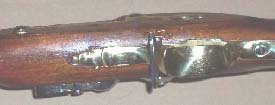



|

|

|
|
|               |
|
This is our 'Long Land Pattern' British musket, also known as the 'First Model Brown Bess'. It is the result of two years of research and development. |
|
Under the Ordinance System, the British army expected 12 years of service out of a musket. Old muskets were turned in to be dismantled. Locks were reworked for use in other guns, barrels were sold as surplus, and brass furniture was recast as new sets in the newest pattern. By the Seven Years War period, 1728 style muskets would have long since been scrapped. As French and Indian War period reenactors, our goal was to replicate the proper musket for mid-18th century through early RevWar use.
Any Long Land musket with a steel rammer would have some sort of nosecap, even if it were converted from an earlier model. The 1742 pattern was basically a 1728 type musket (I.E. wooden rammer) that has been converted to use a steel rammer by changing out the front rammer pipe and adding a sheet brass nosecap. The 1728 type muskets would not have steel rammers without several modifications for it to fit, one modification is a spring added to the front pipe which would keep the rammer from sliding out, the other would be the addition of some kind of nosecap to keep the wooden rammer from buggering up the wood as you returned it to its pipes. If you see a Bess with a steel rammer and no nosecap for sale, it is a fantasy gun. The 1728 type lock, with no bridle on the frizzen, makes it very difficult to securely attach a flashguard without modifying the lockplate.
|
|
What we settled on for a design was the 1756 Pattern. The 1756 pattern of musket uses a double-bridled lock, which allows the use of a flashguard. The 1756 pattern uses a steel, button headed rammer so therefore it uses the cast brass nosecap and long front pipe of the 1756 type muskets that would have seen service here. It also has the correct triggerguard that was introduced in mid-century and stayed the standard for the rest of the 1700's. |
| Accessories for the Brown Bess, such as sling, hammerstall, flashguard, bayonet and period style tools are available separately. |
| A full view of the piece, which features a 46" barrel. |

|
| View from the left. |

|
| A view of the lock. Markings include the Royal Cypher, a broad arrow, and "Tower". Locks of this era had a bridled frizzen. |

|
|
This triggerguard finial type appeared on this model and remained for the rest of the century. The raised roccoco carving around the triggerguard was eliminated at this time as well. |

|
|
Because of the now-standard steel rammer, a cast brass nosecap was used to protect the terminus of the stock. To make returning the rammer more efficient, the trumpet shaped long front pipe was used. |

|